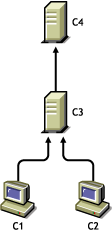4.1 Manual Configuration
Manual configuration is easy to plan, configure, and debug. This type of configuration is best suited in a setup where there are fewer than 15 servers and the servers are in the same geographical location and do not span across a large WAN.
You can manually configure a time synchronized setup by completing the following tasks:
4.1.1 Planning the Setup
You should plan the setup before configuring the time provider and time consumers. The setup consists of a time group, which is a set of servers synchronized for time.
The plan should include the following:
-
Identify the most reliable server in the subnet and make it the time provider.
-
Identify the other servers in the subnet be the time consumers.
4.1.2 Configuring the Time Providers
In manual configuration, a time provider can get time from the following:
-
From another time provider Client-Server Mode
-
From its local clock Self-Synchronized Mode
Client-Server Mode
In this mode, a time consumer takes time from a time provider. The time provider can be a time consumer in another setup or can take time from an external time provider as shown in the figure below.
Figure 4-1 Time Group Taking Time from a Time Provider

To configure the time provider:
-
Add a line similar to the following to the time provider's ntp.conf file:
server IP_address_of_time_provider preferThe prefer parameter marks the server as preferred. All other things being equal, this time provider is chosen for synchronization among a set of correctly operating providers.
ntp.conf file is the configuration file for NTP. This file is located in sys:\etc. For more information, see The Configuration File.
-
Load XNTPD for the changes to take effect.
To do this, enter the following at the command prompt:
Load XNTPD
For more information, see Section 3.1, Client-Server Mode.
Self-Synchronized Mode
In this mode, the server takes time from its own local clock as shown in this figure.
Figure 4-2 Time Group with Self-Synchronization

To configure the time provider:
-
Add lines similar to the following to the time provider's ntp.conf file:
server 127.127.1.0 preferfudge 127.127.1.0 stratum 3
-
Load XNTPD for the changes to take effect.
To do this, enter the following at the command prompt:
Load XNTPD
4.1.3 Configuring the Time Consumers
-
Add a line similar to the following to the time consumer's ntp.conf file:
server IP_address_of_time_provider prefer -
Load XNTPD for the changes to take effect.
To do this, enter the following at command prompt:
Load XNTPD
4.1.4 Sample Scenario
This sample scenario in Figure 4-3 demonstrates how to configure a time-synchronized setup in the manual mode.
Figure 4-3 Sample Scenario for Manual Configuration

In this scenario:
-
C1 and C2 are time consumers that obtain time from the time provider C3.
-
C3 is also a time consumer that obtains time from the time provider C4.
-
C4 is self-synchronized.
To use manual configuration to configure the setup explained in the scenario:
-
In the ntp.conf files of C1 and C2, add a line similar to the following:
server IP_address_of_C3 prefer -
In the ntp.conf file of C3, add a line similar to the following:
server IP_address_of_C4 prefer -
In the ntp.conf file of C4, add a line similar to the following:
server 127.127.1.0 prefer
fudge 127.127.1.0 stratum 3
-
Load XNTPD for the changes to take effect.
To do this, enter the following at the command prompt:
Load XNTPD